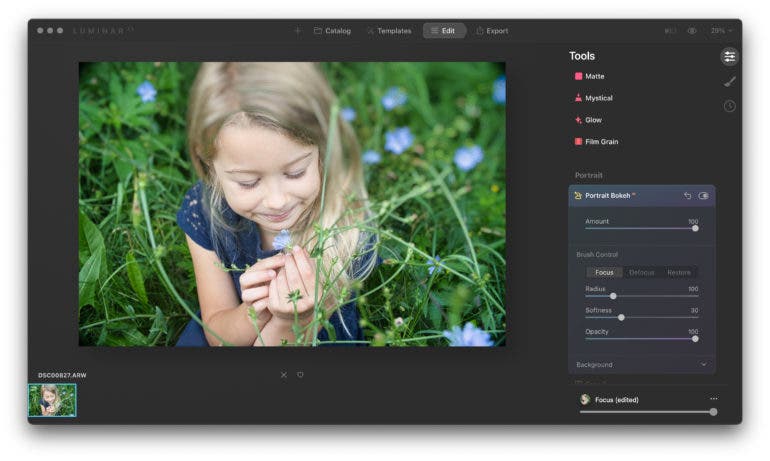Can You Tell What Photo Is from Bokeh AI in the New Luminar AI?
Creamy backgrounds generate bokeh envy. Smartphone companies, using artificial intelligence, have been trying to whet this appetite with portrait modes. But, now a major photo editing software is joining the fray. Luminar AI, a scaled-down, beginner-friendly version of Luminar, has just announced its fourth major update. The refresh includes the addition of a major new tool — Portrait Bokeh AI, The tool, made for portraits, recognizes the subject and offers a few different sliders to control the effect.
But, I’ve rarely been impressed by the artificial blur from my iPhone. Can a major photo editing company do better? I tested the latest version of Luminar AI. to see how well a computer can replicate true bokeh.
Luminar AI Bokeh AI Vs. Zenit 50mm f0.95
I grabbed the most capable bokeh machine currently in my possession, the Zenit 50mm f0.95. I then took a portrait at f0.95 and one at f11, the latter I plugged into Bokeh AI. I literally took this photograph in the weeds next to my recycling bin. It’s a shot that desperately needs some bokeh to make weeds look, well, more magical than weeds. (I was inspired by the color of the flowers but also, the commute to the end of my driveway is very good).
Can you tell which of these shots was taken with the f0.95 lens and which one was computer generated?


Of course, you can — even my six-year-old preferred the real photograph. The f0.95 lens creates bokeh that’s not just butter smooth, but butter-still-being-churned smooth. The blades of grass almost swirl together. And, at f0.95 everything has a soft glow and even most of her face is out-of-focus.
Bokeh AI looks more like crunchy peanut butter. That my kid put away. With the lid off. Three days ago. In the fridge. The software did a good enough job creating the mask — I only had to click on the photo once to select the subject. But, the AI got confused in a few places. The spot in her hair where the background shows through is a mess. The rest of the edges on her hair are too crisp.

I tried to use the brush tool to blur more of her face like the f0.95 lens. But, the grass in the foreground confused the computer. It ended up creating a green outline over everything that I selected. The original mask was less painful to look at, so I went back to that mask.

Bokeh AI vs. iPhone Portrait Mode
Okay, I’ll admit it: that test really wasn’t fair. I intentionally took a photo that I thought would be difficult for AI to bokeh-fy. I knew the foreground would be tricky for a computer to handle. And I knew that no computer could make the swirly bokeh of the f0.95 lens. (What can I say? I’m a portrait and wedding photographer. I don’t want to be replaced by computerized bokeh. *cue evil laugh*)
So, let’s be fair. How does Luminar AI’s new Bokeh AI compare to the iPhone’s portrait mode? I took a selfie in the standard mode on my iPhone. Then, I took one in portrait mode. Finally, I brought the plain selfie into Luminar AI to see how the bokeh would compare to portrait mode.


I still prefer the fake bokeh from my iPhone, but, I learned a few things about the way that the Luminar AI bokeh tool works. First, Luminar AI knows that bokeh is a gradual thing, the iPhone does not. The iPhone just finds the background and blurs it. It’s not horrible in this shot, because it’s a close-up. But, it’s more obviously fake in full-length shots where the ground by the feet shouldn’t actually be blurred.
Luminar AI applies the bokeh gradually so that the bokeh is greatest the farthest from the camera. It doesn’t do this perfectly: there are a few patches that are sharper and blurrier in the bottom half of the background. And, in photos against a wall, it still applied this gradual blur. But, it’s trying. A slider under the background options called “depth correction” allows you to adjust this effect. You can control how quickly the background blurs. Or, remove the effect and just apply one uniform blur to the background.

The second thing I noticed? Bokeh balls. The iPhone portrait mode just applies something like Photoshop’s Gaussian blur to the background. But, if you zoom in on the highlights in the trees in the Luminar AI photo, you can see them: bokeh balls.
Luminar AI isn’t just applying a blur effect to the background. It’s using a bit of understanding on bokeh to apply a blur that deepens with distance and turns highlights into bokeh balls. Now, I still preferred the edges of the mask on the iPhone. Luminar’s is just a little too harsh, and if I try the slider to correct the edge, the background bleeds into the subject. I was able to refine it a little with a brush to get this, which is a few steps ahead of the bokeh that wasn’t manually adjusted. But, the masking is still pretty obvious.

Can Bokeh AI Create a Decent Photo?
After pinpointing a bit about how the new Luminar AI tool works, I kept trying. And, I did, finally, get a photo that didn’t immediately look fake.

Luminar AI knew not to touch the wall close to the camera and instead applied a blur to the parts of the background that were already blurred a bit. The subject is wearing a hat, so the crispier edges aren’t noticeable. I used the brush to touch up one area and the sliders to adjust the intensity of the blur and that was it.
The new Portrait Bokeh AI in Luminar AI does a few things that computerized AI typically doesn’t. It adds bokeh balls and applies the blur gradually as the background deepens. But, it hasn’t yet learned that the focus should fall off gradually from the eyes. Real bokeh doesn’t have crisp edges. The feature is not a compelling reason to buy Luminar AI. As it stands, it will probably just create more fake bokeh photos in your news feed.
That said, I’m still standing by my original thoughts on the software. Non-photographers are going to like the easy tools that do big things. The risk is that non-photographers typically have a difficult time telling when a photo is over-edited. Either way, serious photographers are going to be better off with the full Luminar or another program instead.